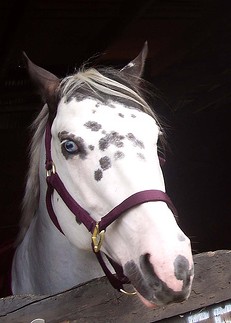A film by Peter Sanders

From time immemorial, peoples from all corners of the globe have summoned the energy stemming from natural forces to transform dis-ease into health. The objective of this film is to capture the power of a horse’s relationship with a person as a source of mystical energy that has proven effective in healing disabled or mentally challenged people. Bringing the camera into that intimate world of the horse’s relationship with its handler, owner, and rider, the mirrors through which we can glimpse into a horse’s psyche, the film explores that ineffable chemistry between animal instinct and human brain that makes possible the healing of a child or adult who has suffered paralysis, a traumatic injury, or a pre-existing birth defect.
This documentary focuses on the work being carried out at the Therapeutic Equestrian Center in Cold Spring, New York, a nonprofit organization founded in 2006 by Leslie Heanue, a lover of horses who, after a 15-year career in finance, opted to pursue her dream of establishing a therapeutic riding center to help people overcome physical, psychological, and emotional barriers. Our protagonists will be chosen from several horses that have proven their innate capacity to heal humans. We will follow them (as inconspicuously as possible) from dusk to dawn, capturing their public and private moments and mapping their character, from past history to therapeutic horse. Some of the filming will take place at night, when horses are alone in their stalls, or when they are grazing in a group setting, or when they are free to do what they feel. The camera itself should become the horse, engaging the viewer in its relationship with its rider from its perspective. The cameras may roll for a whole day at a time just to capture this effect.
We will also engage the viewer in the various stories, particularly about the children whose parents have resorted to the Therapeutic Equestrian Center for relief of their conditions. Specifically, we want to show how the horse and its rider can become one essence and are symbiotically interconnected, bonded by mutual trust. Apart from the ramifications that this documentary might have for the medical profession, the film, which will be shot over an unspecified period of time, will show the impact that this type of therapy has had on the ailing riders, underscoring the possibility of tremendous progress in their physical or mental conditions.
Different types of relationships will be interwoven into the fabric of our multidimensional storyline. For instance, I intend to capture the impact of this type of therapy on a U.S. veteran returning from Iraq and facing PTSD, as well as on a child disabled by paralysis. What I hope to communicate through these relationships is the potential of this therapy to bring out a range of emotions, from playfulness and trust in animals and humans, to hope, spontaneity, pride, self-confidence, and the heightened sense of spirituality that comes from bonding with a horse. For kids, especially those who cannot compete with others on equal grounds, mastering a horse can become a special source of pride.
The documentary also will highlight the crucial roles played by those who mediate between horse and rider, namely the PATH Certified Riding Instructor, the owner, and others on the staff, including volunteers and handlers. Both the Executive Director and the therapist would act as chorus leaders, guiding us through their wealth of experience with the subtleties involved in modulating the relationship between horse and rider. The parents of the children also would be asked to participate in on-camera conversations to help us further understand the child’s struggle, what they have lived through, and how the effects of horse therapy are paying off. If possible and authorized, the riders will be interviewed as well.
Finally, the film will examine the contribution the Center makes to the community by treating children who have been abused or may be scared or depressed, or suffer from some disorder, while taking them on a spiritual journey.
Peter Sanders
Filmmaker
Sanders Productions
T:9175544100
Please refer to the contact page to reach me directly.
www.SandersProductions.com
www.AltinaTheFilm.com
www.thedisappearedmovie.com





